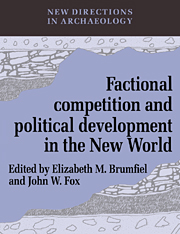Book contents
- Frontmatter
- Contents
- List of figures
- List of tables
- List of contributors
- Preface
- PART I INTRODUCTION
- PART II CHIEFDOMS
- PART III STATES
- 7 Ethnicity and political control in a complex society: the Tarascan state of prehispanic Mexico
- 8 Ethnic groups and political development in ancient Mexico
- 9 Factional divisions within the Aztec (Colhua) royal family
- 10 Alliance and intervention in Aztec imperial expansion
- 11 Political factions in the transition from Classic to Postclassic in the Mixteca Alta
- 12 Internal subdivisions of communities in the prehispanic Valley of Oaxaca
- 13 Cycles of conflict: political factionalism in the Maya Lowlands
- 14 Political cosmology among the Quiché Maya
- 15 Factions and political development in the central Andes
- PART IV DISCUSSIONS
- Bibliography
- Index
10 - Alliance and intervention in Aztec imperial expansion
Published online by Cambridge University Press: 18 December 2009
- Frontmatter
- Contents
- List of figures
- List of tables
- List of contributors
- Preface
- PART I INTRODUCTION
- PART II CHIEFDOMS
- PART III STATES
- 7 Ethnicity and political control in a complex society: the Tarascan state of prehispanic Mexico
- 8 Ethnic groups and political development in ancient Mexico
- 9 Factional divisions within the Aztec (Colhua) royal family
- 10 Alliance and intervention in Aztec imperial expansion
- 11 Political factions in the transition from Classic to Postclassic in the Mixteca Alta
- 12 Internal subdivisions of communities in the prehispanic Valley of Oaxaca
- 13 Cycles of conflict: political factionalism in the Maya Lowlands
- 14 Political cosmology among the Quiché Maya
- 15 Factions and political development in the central Andes
- PART IV DISCUSSIONS
- Bibliography
- Index
Summary
The growth of the Empire of the Triple Alliance, or Aztec empire, is recounted in a number of sources, and all of them describe how it was built through wars of conquest waged by the allied cities of Tenochtitlan (modern Mexico City), Tetzcoco (Texcoco), and Tlacopan (Tacuba). These conquests began with the overthrow of the Tepanec empire in 1428, and did not end until the Spanish conquest in 1519. The Mexica of Tenochtitlan and their allies fought and vanquished other states, and demanded tribute and submission as a price for peace. Yet recent analyses have also given us a picture of the empire as an alliance between the ruling elites of the subject states and those of the imperial centers, in which the former derived substantial benefits from being in the empire. They were dependent on the continued patronage of the imperial rulers (Brumfiel 1983), but they were given valuable gifts by these same rulers, they participated with them in lavish feasts, they received lands, and they could count on imperial support as they exploited the common people of their own realms (Smith 1986, Calnek 1982). They retained considerable autonomy, including the command of their own military force, and Hassig (1985:92ff) has characterized the empire as “hegemonic.”
A question immediately arises. If the ruling elites of the subject states derived such benefits from being in the empire, why was it necessary to wage war against them to force them into it? Part of the answer may lie in the processes by which states were incorporated into the empire, and the ways they were politically restructured once they were in it.
- Type
- Chapter
- Information
- Factional Competition and Political Development in the New World , pp. 111 - 116Publisher: Cambridge University PressPrint publication year: 1994
- 7
- Cited by



